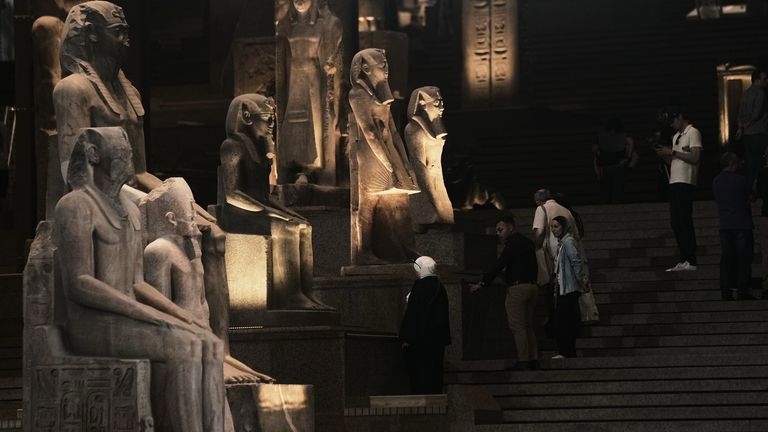
Visitors at opening of the Grand Egyptian Museum in Giza, where a towering statue of Ramses II welcomes guests and a staircase lined with ancient kings and queens [Image by Sky News]
(The Post News) – On Saturday, Egypt officially inaugurated the Grand Egyptian Museum, a historic moment next to the Giza Pyramids. The world’s largest archaeological museum seemed to bridge between Egypt’s ancient legacy and its modern ambition to revive tourism to strengthen the economy.
A Monument Two Decades in the Making
Located just two kilometres away from the Great Pyramid of Khufu, the opening of the Grand Egyptian Museum is more than 20 years of planning and construction. It is estimated to cost upwards of $1.2 billion on the huge complex of 500,000 square meters, roughly the size of about 70 football fields. Its glass façade, with an angular shape like a pyramid, mirrors the surrounding desert wonders in a geometric form.
The triangular shape in glass, merged with the alabaster walls inscribed with hieroglyphs, balances innovation with heritage. Visitors enter via a large atrium dominated by an 11-metre-high statue of Pharaoh Ramses II, moved from Cairo’s railway square. Further inside, a monumental staircase lined with the figures of ancient kings and queens rises to the main galleries; from this vantage point, the view out onto the Giza Plateau is thrillingly panoramic.
President Abdel-Fattah el-Sissi, the champion of the project, hailed the museum as “a symbol of Egyptian creativity and civilization.” He added that it unites “the genius of ancient Egyptians with the innovation of modern Egyptians.”
Most of the moment from the Grand Egyptian Museum opening, the entire collection of King Tutankhamun is on display, shown together for the first time since the British archaeologist Howard Carter discovered the boy king’s tomb in 1922. Over 5,000 artefacts now occupy two grand halls: Tutankhamun’s golden throne, six chariots, his jewelled mask, and the gold-covered sarcophagus.
Dr. Zahi Hawass, Egypt’s most celebrated archaeologist, has referred to the Tutankhamun exhibit as “the masterpiece of the museum.” “The whole world has been waiting for this moment,” he said. “Tutankhamun himself represents the heart of Egyptology.”
The museum contains the treasures of Tutankhamun, along with the 4,500-year-old solar boat of Pharaoh Khufu, the obelisk of Ramses II, and thousands of other relics from pre-dynastic times up to the Greco-Roman period.
The GEM represents so much more than a museum; it is actually a cornerstone for Egypt’s national revival strategy. The government has upgraded the roads, a new metro station, and the Sphinx International Airport nearby are other developed changes.
Tourism officials hope the GEM will attract as many as 8 million visitors annually; these tourists will bring much-needed foreign currency into the economy. Egypt welcomed a record 15.7 million tourists in 2024, accounting for roughly 8 per cent of its GDP. Authorities are seeking to double that figure to 30 million by 2032.
The Egyptian tour guide Walid el-Batouty insists: “This museum is going to change Egypt’s tourism sector completely. Every single visit means employment, means economy, means international interest. It’s about the future, it’s not about history.”
Meanwhile, this also tightens the case for Egypt to ask for iconic artefacts kept abroad. Egyptologists again start to raise calls for the return of the Rosetta Stone, presently housed in the British Museum, the Dendera Zodiac now kept in the Louvre, and the Bust of Nefertiti from Berlin’s Neues Museum.
Dr. Hawass added, “This museum proves Egypt can conserve and present its treasures with excellence. It is time for these artifacts to come home.” Online petitions demanding that they be returned have already gained hundreds of thousands of signatures.
A New Hub for Discovery and Conservation
In addition to exhibitions, the Grand Egyptian Museum also functions as an international center for research and conservation. With the help of advanced technology, Egyptian experts have also renovated hundreds of pieces from the tomb of Tutankhamun in the museum’s laboratories.
Dr. Tarek Tawfik, the former director of the museum, mentioned the following: “The GEM sends a message of both ancient genius and modern Egyptian know-how. Our conservators have impressed their international colleagues by means of their accuracy and professionalism.” The opening of the Grand Egyptian Museum is more than the unveiling of a cultural site; it heralds Egypt’s resurgence into the world arena of history, art, and discovery.
The museum will finally open to the public on November 4, the anniversary of the discovery of Tutankhamun’s tomb. As the sun sets over the Giza Plateau, it infuses the glass façade, signifying a new pyramid of light, a fitting tribute to Egypt’s timeless civilization and its bright future.



